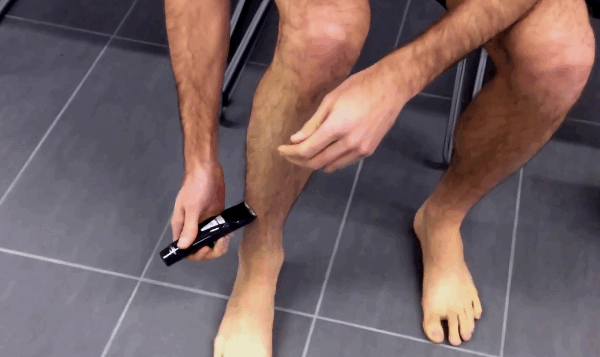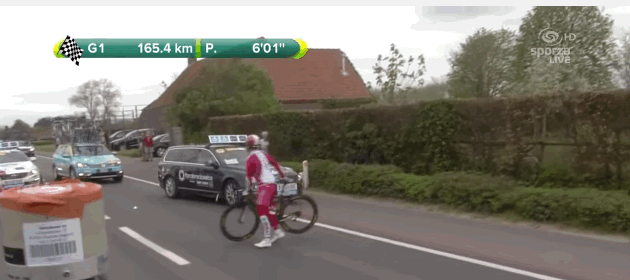![paris bike snow eiffel tower]()
[Editor's note: This article was first published in April 2013. With the spring weather finally approaching, we've decided to republish it.
Copenhagenize is a consulting and communications company that specializes in all things cycling-related. The company gave Business Insider an exclusive first look at its new ranking of the world's most bike-friendly cities.]
There are lots of cities where it's good to be a cyclist, but some are truly two-wheel paradises.
The newly released Copenhagenize Index 2013, produced by the Copenhagenize Design Co., ranked 150 cities around the world on 13 parameters, including cycling facilities, culture, sharing program, gender split, politics, and traffic calming.
It also gave bonus points for categories like political leadership.
Here are the top 20 cities, each with a score out of 100 points.
The list starts at number 14, since there are a few ties.
14. Hamburg, Germany
![]()
Score: 54
2011 Rank: 13
Why It Works: The Index always offers up surprises. More often than not it is when cities show up on the list. To be honest, we were surprised that Hamburg made the cut and clung onto the last spot in the Top 20.
In a global perspective, Hamburg is a premier league player, no doubt about it. The city's modal share has been steady and is slowly rising. The citizens are returning to the bicycle, especially in the neighborhoods.
The city's planners haven't really realized that it's a new millennium and much of their infrastructure is sub-standard. But it's there. Ready to form the foundation for more, better protected cycle tracks.
Fixes: If Hamburg gets the right political leadership, the city will blossom as an urban cycling paradise. The need for infrastructure that adheres to best practice is becoming more and more apparent.
The 20th spot on the Copenhagenize Index is a fragile position to be in what with so many other cities making impressive efforts and eager to move up the list. Get with the global programme or get left behind. You're snuggled in between Copenhagen and Amsterdam.
Figure it out.
Scoring: Cities were given between 0 and 4 points in 13 categories, with a potential 12 bonus points for particularly impressive efforts or results, for a maximum of 64 points. The final score was adjusted to be out of 100. Categories included advocacy, bicycle culture, cycling facilities, infrastructure, bike share program, gender split, modal share, modal share increase since 2006, perception of safety, politics, social acceptance, urban planning, and traffic calming. See the full index at Copenhagenize.
13. Paris, France (tie)
![]()
Score: 55
2011 Rank: 7
Why It Works: The second global mega-city on the list after Tokyo, Paris continues to impress. If every city had political vision like Paris, regarding liveable cities, the world would be a better place.
Paris has left London and New York in the dust over the past six years. In particular, New York is making efforts to catch up, but Paris' commitment to improving conditions for Citizen Cyclists remains strong.
The city's bike share system remains a success and an impressive number of stretches feature bicycle infrastructure.
With 30 km/h zones and the removal of archaic expressways along the river, bicycle traffic will benefit. The fantastic role of the bike share system in the nightlife shows that the citizens are embracing the bicycle for all purposes. Nobody would have thought that Paris could have done all it has done but the city continues to pinch us to tell us we're not dreaming.
Fixes: Planners have been searching for space for bicycle infrastructure and Paris has some unique solutions. They are, however, solutions that are not sustainable in the long run.
It's time to up the stakes and go after a more permanent solution with the creation of more protected cycle tracks. The success of the bike share system is impressive but better maintenance is required, as well as increasing the number of stations at both transport hubs and popular nightlife neighborhoods.
Scoring: Cities were given between 0 and 4 points in 13 categories, with a potential 12 bonus points for particularly impressive efforts or results, for a maximum of 64 points. The final score was adjusted to be out of 100. Categories included advocacy, bicycle culture, cycling facilities, infrastructure, bike share program, gender split, modal share, modal share increase since 2006, perception of safety, politics, social acceptance, urban planning, and traffic calming. See the full index at Copenhagenize.
13. Budapest, Hungary (tie)
![]()
Score: 55
2011 Rank: 10
Why It Works: Budapest continues to build upon the successes of the past few years, although we fear the pace may have slowed. The city's force remains visionary advocacy and the social acceptance of the bicycle.
One of the leaders among Emerging Bicycle Cities, Budapest is getting it's brain wrapped around infrastructure and development of a sensible network for bicycle users.
A city that can gather 50,000-80,000 for peaceful bicycle rides has some golden opportunities that can and must be exploited.
Fixes: Like every other city on the planet, it's all about the infrastructure. The city has brilliant advocacy, but it is now time to push for more protected cycle tracks. Paint ain't the same.
Budapest is a regional leader in bicycle culture but without political will and a modern desire for mobility change, their role will be overtaken by others. The upcoming bike share system, if implemented correctly, will be a game-changer for the city.
More infrastructure should be in place before the bike share system starts up.
Scoring: Cities were given between 0 and 4 points in 13 categories, with a potential 12 bonus points for particularly impressive efforts or results, for a maximum of 64 points. The final score was adjusted to be out of 100. Categories included advocacy, bicycle culture, cycling facilities, infrastructure, bike share program, gender split, modal share, modal share increase since 2006, perception of safety, politics, social acceptance, urban planning, and traffic calming. See the full index at Copenhagenize.
See the rest of the story at Business Insider
 Only about 2% of London's 8 million+ residents ride bikes to get to work each day, according to an analysis by the Transport for London.
Only about 2% of London's 8 million+ residents ride bikes to get to work each day, according to an analysis by the Transport for London.
 Michael Hutchinson
Michael Hutchinson





























 For the better part of a century, team helpers have had to awkwardly stuff their already tight jerseys with a half dozen or so water bottles, handed out from team cars, then ride back through the pack, delivering each bottle to thirsty teammates — hopefully without dropping a slippery bottle and causing a crash.
For the better part of a century, team helpers have had to awkwardly stuff their already tight jerseys with a half dozen or so water bottles, handed out from team cars, then ride back through the pack, delivering each bottle to thirsty teammates — hopefully without dropping a slippery bottle and causing a crash.

 He apologized to the organizers for breaking the rules and thanked them for letting him off with only a warning:
He apologized to the organizers for breaking the rules and thanked them for letting him off with only a warning:









 And the duo rode well together. At one point their lead over the peloton reached nearly nine minutes. Things were looking pretty good.
And the duo rode well together. At one point their lead over the peloton reached nearly nine minutes. Things were looking pretty good. Breakaways rarely succeed at the Tour, so as the kilometers ticked away, people were starting to wonder: Could these guys actually make it to the finish?
Breakaways rarely succeed at the Tour, so as the kilometers ticked away, people were starting to wonder: Could these guys actually make it to the finish? At 400 meters to go — with the peloton surging behind — Bauer sprinted, leaving an exhausted Elmiger in his wake. Bauer gave it absolutely everything.
At 400 meters to go — with the peloton surging behind — Bauer sprinted, leaving an exhausted Elmiger in his wake. Bauer gave it absolutely everything. It's not the first time the Tour was brutally unforgiving of its riders, or Bauer, and it won't be the last. In last year's Tour, Bauer crashed hard and had to quit the race:
It's not the first time the Tour was brutally unforgiving of its riders, or Bauer, and it won't be the last. In last year's Tour, Bauer crashed hard and had to quit the race: Alas, this year again, the Tour was not kind to him.
Alas, this year again, the Tour was not kind to him. To add insult to injury, Bauer didn't even get the prize for being the day's "Most Combative" rider. That honor went to Elmiger, who initiated the breakaway.
To add insult to injury, Bauer didn't even get the prize for being the day's "Most Combative" rider. That honor went to Elmiger, who initiated the breakaway.

